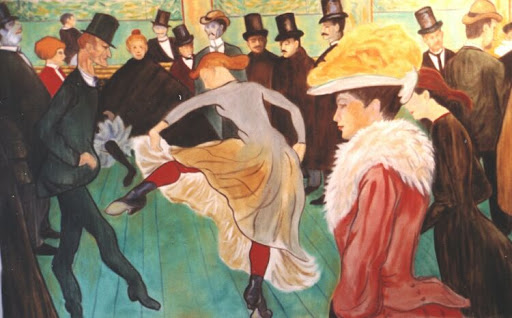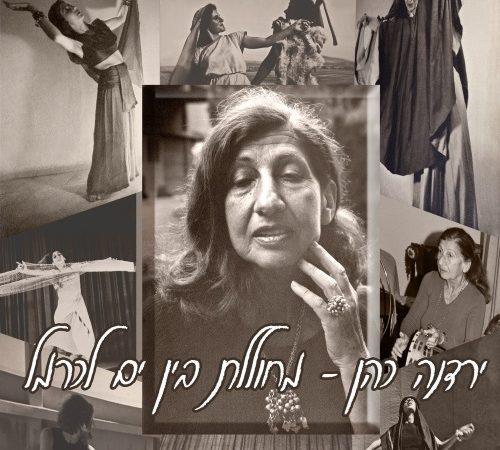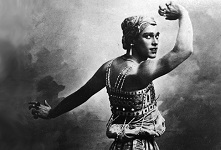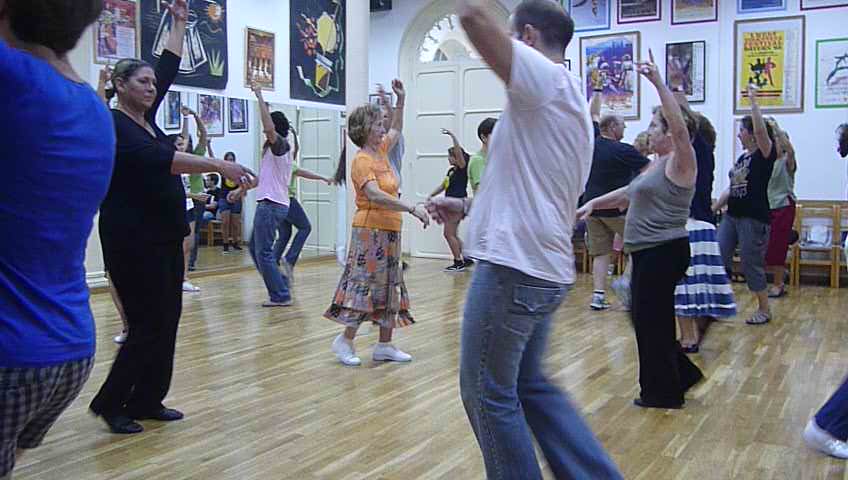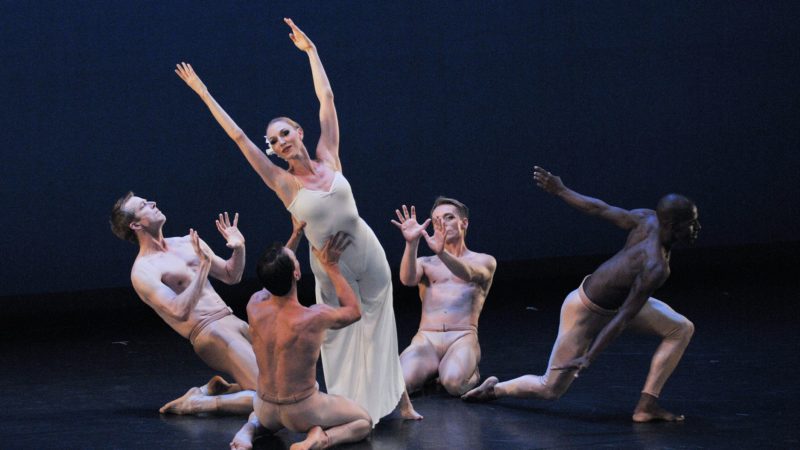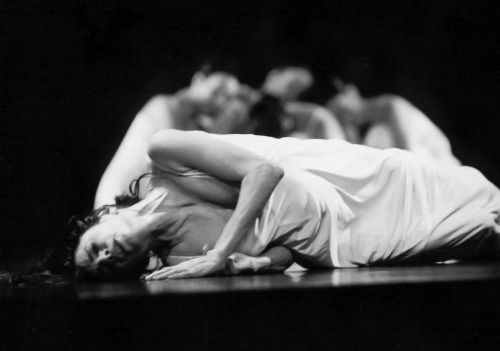Critical junctures in spectator / performer interactions in Tetris by Noah Dar
The Israeli choreographer Noah Dar and the plastic artist Nati Shamia-Ofer collaborate in Tetris,a dance that was ordered in 2006 by the Akko Festival of Alternative Theatre in Israel (The dance was awarded for its innovation). The dialogue between the artists generates a unique performance space in which the viewers observe the occurrence from the place where the dancers' feet meet the dancing floor. Shamia-Ofer created for this dance a special structure – a raised wooden floor, in which openings were made. The viewers stand under that surface, insert their heads through the openings and watch the dance.
Tetris deals with "a renewed examination of the viewer/performance/space relationship" (quoted from the programme). The manipulation of the holed stage enables Dar to break the traditional safe and familiar distance between performer and viewer and its accompanying conventions. The location, an unfamiliar territory, enables the performers and viewers a different dance experience. In other words, the viewers' penetration of the performance space exposes the dancers to their invasive gaze. They can see from a close distance the dancers' skin surface and sweat, at times only body parts, or witness their emotional exposure. At the same time the performers can utilize the great vicinity to seduce, manipulate or threaten the viewers trapped in the performance space.
The intimacy imposed on the spectator/performer's relationships in Tetris, the tension created between proximity and distance, alienation and involvement in the common experience, all draw attention to the affect the stage shape has on ways of seeing (Rottenberg, 2009). The affinity between the stage shape and the viewing experience has developed in the West since the Renaissance spectacle. The proscenium stage (invented in Italy in 1580 by Andrea Palladio) has its imprint on the development of theatrical dance and is marked to date. The new visual perspective in the auditorium shaped hall, has requested specific type of art works and artists. Hence, it emphasized the strengthening of the professional dancer's status, the frame and the picturesque illusion of the stage, and brought about the separation and social alienation between viewer and performer.
Comprehending the human gaze or the human perspective in western culture is considered a fundamental concept, and since the 20th century its stature has intensified (see for example Berger, 1972; Mulvey, 1996). Criticism on institutional dance in the West has led to radical changes in the way performance space is perceived by artists, and to the abandoning of the concept of performance as being neutral and autonomic, unaware of being looked at. One of the prominent examples is the multimedia event at Black Mountain College in 1952 at Black Mountain College, organized by John Cage and Merce Cunningham, generated a new paradigm (Connor, 1997(. In it the viewers were seated in a square arena demarcated by diagonal passages into four triangles seeing Cunningham improvising in the aisles, a movie screened on the ceiling, Cage reading a text, and David Tudor playing a tuned piano (Goldberg, 1996).
These radical ideas had a distinct affect on Judson Dance Theatre experiments and inquiries in the 60's that challenged problems of defining dancing, among them ‘ways of looking' (Banes, 1987; Connor, 1997). Yvonne Rainer deserted the viewer's voyeuristic gaze in her work Trio A (1962), in which she focused the viewers' attention on movements based on carrying out an assignment. Trisha Brown undermined the position of the narcissist performer in Insider (1966), in which she challenged the viewers, looking straight at them while moving to and fro on the edge of the stage. These works, performed in unconventional sites, had real effect on concepts of choreography as well as on the viewers' observation experience.
Philosophy and cinema in the 20th century have inspired considerably the discourse on the look concept, demonstrating new possibilities of thought about the human being in various contexts. This paper combines two approaches towards the way of looking, when reading Tetris. One is based on The Look (2007) by Jean-Paul Sartre, and the other on Visual Pleasure and Narrative Cinema by Laura Mulvey (1996). These will serve to discuss how affluent activities in the dance indicate visual power, sometimes conceptualizing it as paralyzing and violent.
Looking with Sartre (2007) is perceived as a visual structure in the framework of a model based on power. Sartre focuses on looking in order to re-formulate that phenomenon as an inter-personal action in the visibility field. In it, the subject can see the other person and thus encounter him/her as an object, or alternatively put himself as the object of the other person's look and thus encounter the other person as a subject. With Sartre (2007), only one of the two is possible, since by the mere visual affinity to the other person, one is necessarily either the subject or the object. Since in the inter-personal encounter looks cannot meet nor be mutual, an entire synthesis between the two forms is impossible.
This conflict shows how via the look, while I aspire to subjugate the other person, the latter aspires to subjugate me. Sartre's look dialect is not only formulating it as power, but the conceptualization of the visual power as an aggressive one, which necessarily turns its object to a victim. This occurs by the mere decrease of his human presence to the presence of an object.
Laura Mulvey (1996) relates to the gaze as power operator in the context of visual pleasure and narrative cinema. She uses psychoanalysis as a political weapon to demonstrate the way the unconsciousness of patriarchal society has structured film form. She argues, among other things, that there are "circumstances in which looking in itself is a source of pleasure" (1996: 113), as well as the pleasure to be looked at. Both arise from the pleasure of using another person as object of sexual stimulation through sight.
Mulvey (1996) argues that the shared experience between the subject's gaze directed at the performing object and the object awareness of the gaze's intensity, all demonstrate how various aspects – the performance space, the viewing experience, and the total involvement of the action participants – all draw attention to the links between the act of looking and the total involvement demanded from creators, performers and spectators.
The boundaries of intimacy
The audience in Tetris (a game-performance) faces the viewing experience upon entering the theatre. As in a secular ritual, each one of the viewers – all together 69 – passes through a narrow gate where they are required to take off their shoes, their height is measured and respectively they receive stools in various sizes. The viewers, led by 7 dancers (Adaya Fershkovsky, Coralli Ladam, Lilly Ladin, Irad Matzliach, Shira Rinot, Nahshon Stein and Oren Tishler), are seated on their stools in front of the raised stage. This way, already upon entering the dance site Dar breaks the solidarity of the way of looking by actually drawing the viewers' attention to the extraordinary stage and focusing their attention on the notion of the new intimate physical and mental distance created between viewer and performer. Thus, she demonstrates the power of staging upon way of thinking.

Photo: Tamar Lam
After all the viewers have gathered, a voice asks them to get under the raised stage and place the stools in the marked places. The voice continues instructing them to cautiously mount the stools and push their heads through the open holes in the raised dance floor. Not only is the audience surprised not to be seated in the traditional darkness of an auditorium, but the revealed scenery places them in a "decapitated" field of heads. Pairs of eyes look with embarrassment at each other and mouths laugh with uneasiness.
The audience's presence is part of the dialectics of that occurrence, since their embarrassment – emotional as intellectual – turns out to be an essential drive in such a performance. This embarrassment is caused by their inability to discern between ordinary and artistic action, to figure out the artistic form or to identify the difference between performer and spectator. Furthermore, the detachment of heads from bodies left under the raised stage intensifies their self-alienation. When the dancers crawl and move between and over the viewers' heads, protected by a metal lattice around them, their vulnerability builds up. The various manifestations of intimacy imposed on the viewers by the dancers threaten their existence as subjects, and as Sartre (2007) asserts it exposes them to the subjugation of the Other.
The close physical and emotional proximity, the encroachment of the personal space and the blurring of the safe distance boundaries between dancers and viewers, all generate excitement and evoke temptation. The tension is created by twisting bodies touching each other with passion, thighs wiggle in sensual movements, or dancers try to undress each other. Thus, the penetration into the performance exposes the viewers to the manipulating power of the moving bodies associated with erotic pleasure. But, unlike the pleasure of looking generated in film (Mulvey, 1996), the bodies in the dance are not there only to be seen or to play on the spectators' voyeuristic fantasy. When reaching the peak of creating the fantasy, it falls apart with the threatening sounds of stamping feet on the wooden floor, bodies jump high up in the air almost touching the ceiling, or hover over the astound heads. The expectations from the pleasure of voyeurism and subjecting the Other, the performers, to the controlling and curious gaze, as Mulvey (1996) claims, are all shattered.
The increased self-alienation and the threatened existence of the riveted spectators to their places demonstrate the dancers' power, enabling them to turn from objects to subjects. They invite the viewers to take part in the illusion of voyeurism into the private world, yet simultaneously they destroy the illusion by publically exposing the personal and the intimate. The emotional stripping of a dancer, pouring upon herself water that mixes with her tears, for example, is a violent manipulation on the viewers that turns them into objects. As Sartre (2007) asserts, the look through which the other is revealed to me is the one that threatens my existence as a subject and aspires to subjugate me, turning me into a victim via the violent power of his look.
Dar and Shamia-Ofer trap the viewers in a unique space, but also enable them a get away. However, the viewers, who decide to slide down beneath the stage surface for a short break from the intensity of the performance, face a no less surprising surrealistic scenery – a world bustling with passive movement of "decapitated" bodies (Yodilevitch, 2006). If previously the viewers and the dancers tackled with heads separated from bodies, now the spectator tackle headless bodies. The dance critic Eshel (2007) describes it as: "The passive bodies which remained under the ceiling/stage recalled meat suspended on hangers at the butcher's". The separation between the "thinking" head and the "feeling" body, exhibited as a peel, intensifies due to the passivity of the viewers' as opposed to the active and moving dancers.

Photo: Tamr Lam
Watching a video, filmed during the performance and screened on a huge screen marks the second part of the dance. It empowers the complex network of looks: the seated viewers that look at themselves watching the dancers and the other viewers, and the dancers look at the other dancers and their awareness of the viewers. Dar conducts them all by operating the camera and directing the lens. At the same time, observing the performance through the video film emphasizes the common experience to both the viewers and the dancers, but also enables the viewers to observe the occurrence from a distance.
The last section of the performance is apparently of a traditional nature. The viewers leave their places under the stage and watch the dance while seated on stools facing the stage. Back to their traditional safe and secure place they watch the dancers squeeze through the openings, through which the viewers' heads have previously emerged, and move between the two spaces – above and underneath the stage floor. Like bats hanging on the tree's branches they dance in an upside-down world.

Photo: Tamr Lam
To sum up, in Tetris, Dar engages in extending the dance boundaries when she investigates the issue of the performance space and its viewing experience. She rejects the voyeurism act as key part of the viewing experience in a dance performance and demands total involvement of all the action participants. Dar uses the look manipulation both as a visual pleasure and as a mechanism of power in order to present a new order in the theatre. It is no longer the viewer's threatening gaze at the dancer in her work. Her mere use of a different dancing space, creating a physical separation between head and body and breaking traditional distance between spectator/performer empowers the performer as a violent and paralyzing force upon the viewer riveted to his/her place.
Copyright 2010, Henia Rottenberg
This paper was presented at the SDHS 2010 conference: Dance and Spectacle.
Bibliography
Banes, S. Terpsichore in Sneakers: Post-Modern Dance. U.S.A.: Wesleyan University Press, (1977) 1987.
Berger, J. Ways of Seeing. London: Penguin Books, 1972.
Connor, S. Postmodern Culture: An Introduction to Theories of the Contemporary. Oxford: Blackwell, 1997.
Eshel, R. "At the mercy of the gigantic reptiles". Ha'aretz. 26.4.2007. [Hebrew]
Goldberg, R. Performance Art. London: Thames and Hudson, (1988) 1996.
Mulvey, L. "Visual Pleasure and Narrative Cinema". In Anthony Easthope, ed., Contemporary Film Theory. London & New York: Longman. (1975) 1996, 111-124.
Rottenberg, H. "Fringes at the Center: Tetris by Noah Dar". Dance Today. 2009, 16: 59-55.
Sartre, J. P. The Look. Translation: Lahav Avner. Tel Aviv: Resling, (1943) 2007. [Hebrew].
Yodilevitch, Merav. "To detach the head from the body". Yediot Aharonot. 16.11.2006. [Hebrew]
